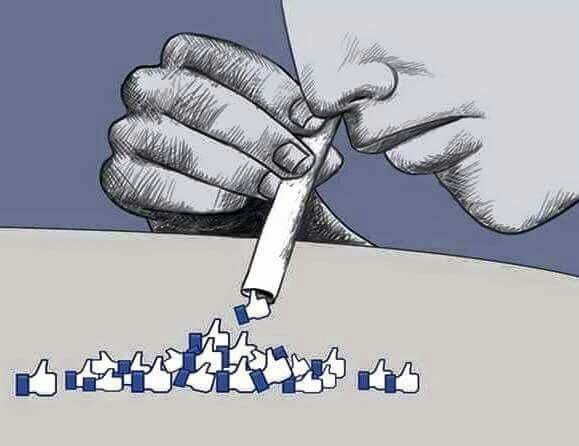 By: Nathan Daley, MD, MPH This article is copyrighted by GreenMedInfo LLC, 2014
By: Nathan Daley, MD, MPH This article is copyrighted by GreenMedInfo LLC, 2014When describing the cultural impact of social media, to call it “phenomenal” would be an understatement. But is the overuse of social networking sites like Facebook on par with the use of physically addictive and/or mind-altering substances?
In a trend that shows no signs of slowing, the number of people who use social media has experienced a meteoric rise from just under a billion worldwide users in 2010, to more than 3 billion estimated users by 2021.[1] With nearly 2.2 billion active users each month,[2] Facebook leads the pack as the social networking site (SNS) where we’re spending the bulk of our time online.
Not only are more people using social networking sites, we’re also spending increasing amounts of time each day liking, commenting, and sharing our lives online. Don’t assume that this is only a fad amongst young people: since 2012, adults are spending 50% more time on Facebook each day. An adult in the U.S. uses Facebook for an average of 135 minutes per day, equating to nearly 16 hours—that’s two, full workdays—per week.[3] What accounts for the magnetism people young and old, feel for social media?
Social Engineering
Let’s break it down into parts. Social—our inherent human need to connect. Media—today, media is essentially, digital information. It comes in many forms: articles, photos, videos, infographics, to name just some of the media types we are routinely exposed to on social networking sites. So far, it doesn’t sound all that sinister, right?
This is the part that should prick everyone’s ears. The delivery of articles, ads, and even your Friend’s posts, is called “serving content.” This content is designed to stimulate our sense of connection, or opposition, with the world around us. Marketers know what keeps us up at night, and they know what we are (Google) searching for. The exact content that YOU are getting served is determined by complex, proprietary algorithms, and code that adapts to nearly every online action that you take. One thing is certain: you are being served content that are specifically curated to get your attention. Sure, it’s addictive. It’s designed to be that way.
We live in a time when many people feel socially insecure. “FOMO,” the “fear of missing out,” is a known motivator, especially among younger users of social media, that keeps them in a state of habitually checking social accounts for status updates, responses to posts, reactions to shares. For some, the ability to Like, Share, and Comment on Friend’s musings provides a sense of engagement that feels real, and is on our time, and our terms—a safer and more economical alternative to actually socializing. We take willing part in this process, applying glamorous filters through which we selectively share our lives.
“God Only Knows What It Is Doing To Our Children’s Brains”
What if all the “feel good” we get in this virtual interaction comes at a price—that we are unwittingly addicted to social media? According to Sean Parker, the founding president of Facebook, that was the company’s intention all along. When referring to Facebook’s earliest mission, Parker said: “How do we consume as much of your time and conscious attention as possible?”
Parker, who came clean about his former company’s agenda at the Axios conference in November 2017, described the Facebook founders conscious exploitation of “a social-validation feedback loop” that plays on inherent vulnerabilities in human psychology. “The inventors, creators — it’s me, it’s Mark [Zuckerberg], it’s Kevin Systrom on Instagram, it’s all of these people — understood this consciously. And we did it anyway.”[4] When the makers of the machine expose its underpinnings, look away at your own risk. It’s time for a wake-up call: every user of social media should know what happens when our brains get stuck in this loop, and what we can do to get unstuck.
Read the entire article here: http://www.greenmedinfo.com/blog/are-you-addicted-facebook

 By:
By:  By Jonathan Landsman
By Jonathan Landsman By Lori Alton
By Lori Alton This is a MUST WATCH video by Melissa Dykes – TruthstreamMedia.com
This is a MUST WATCH video by Melissa Dykes – TruthstreamMedia.com This brain control technique and many others were actually developed by the deep state years ago and this ability is active right not through the “Cell” towers in almost all western countries. Are you having trouble getting to sleep or regularly waking up at 3am? Welcome to the misuse of advanced technology.
This brain control technique and many others were actually developed by the deep state years ago and this ability is active right not through the “Cell” towers in almost all western countries. Are you having trouble getting to sleep or regularly waking up at 3am? Welcome to the misuse of advanced technology. The deep state is tricking the local councils in communities worldwide to install blue light street lights on the pretext that they are cheaper because they draw less power. But this is another depopulation thrust because it causes sleep deprivation that we cannot afford and the disruption to the body’s natural rhythms.
The deep state is tricking the local councils in communities worldwide to install blue light street lights on the pretext that they are cheaper because they draw less power. But this is another depopulation thrust because it causes sleep deprivation that we cannot afford and the disruption to the body’s natural rhythms.